The first week on any expedition is usually the toughest. Our education specialist, Roberta Ayres, was told in the States that she did not need a visa because she is a Brazilian citizen (still!)—like Humphrey Bogart in Casa Blanca, she was misinformed! She had to spend this last week in Lisbon, while I and the two botanists, Jim and Tom, continued on. Our arrival was fine except that the bag that contains all of my field gear failed to make it. On the other hand our great friends at Omali Lodge, Jannie the manager, Cecilia, Suresh and all our AFRICAS EDEN supporters were here to welcome us and once again, we are able to do our work with reliable power sources and in considerable comfort. Happy to say, Roberta, all of her bags and my missing one showed up at 0530 this morning.
In the absence of Roberta, I have been meeting with people about our education ideas, but only those I already know and who speak English. Two of my oldest island friends are Ned Seligman and Enrique da Costa.
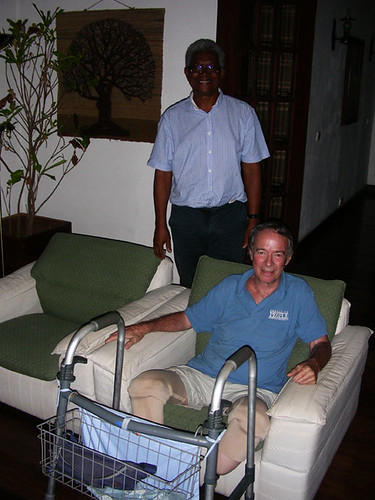 Enrique Pinto da Costa and Ned Seligman (sitting). RCD phot GGIV
Enrique Pinto da Costa and Ned Seligman (sitting). RCD phot GGIV
[Enrique and Neddy]
Enrique is a former member of the STeP government and a true intellectual; probably the foremost historian of the islands (from an ecological sense, as he would say), and my talks with him have been extremely valuable. Ned is a lifelong friend from San Francisco who lives here and is responsible for my first visit 10 years age. He appears in many earlier blogs as does his NGO, STeP UP.
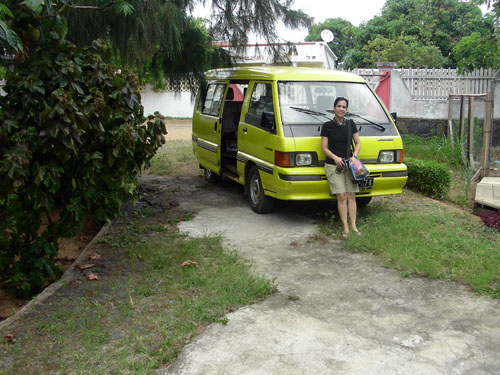
Roberta Ayres and our field taxi. RCD phot. GG IV
One of the vehicles we have rented (again, from friends) is an old taxi suitable for Roberta and I to drive around towns to our meeting but definitely NOT for doing field work. It is a little like driving an old washing machine.
One of our first collecting sites was Ned’s house. He built the ocean front house while he was running the Peace Corps in Guinea Bissau and it is our home-away- from home.
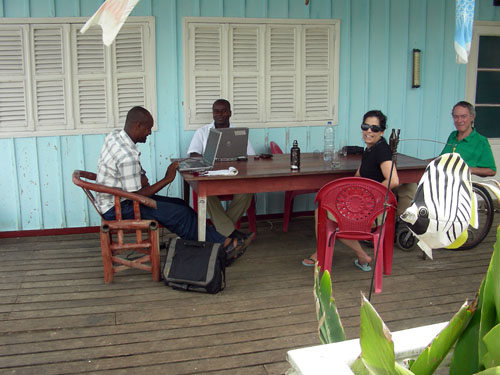
James and Rui (computer guys), Roberta and Ned on the deck. RCD GG IV
Ned told me there were some weird critters living on the wall, under the tapestry that hangs above his bed.
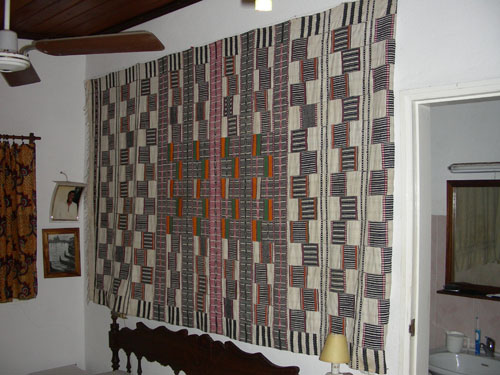
'Habitat" above Ned's bed. RCD phot GG IV
I scraped a bunch off the wall, took some quick photos and sent them off to Norm Penny (who else) of CAS entomology.
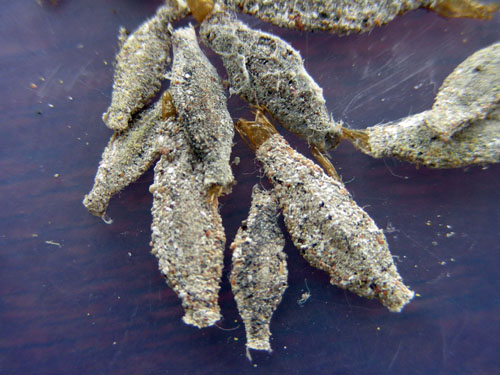
"Bagworms"... moth larvae. RCD phot GG IV
Norm wrote back that these were the larval sacs of a moth species, known in common parlance as “bagworms.” Ned is not amused. Although they are not harmful, they have a weird smell.
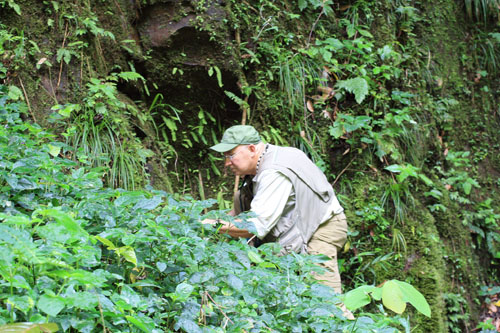
Jim, our bryophyte guy at Cascata Sao Nicolau. T Daniel phot. GG IV
Our intrepid (and exhaustible) bryophyte specialist, Jim Shevock, is up to 300 specimens, and a tad frustrated as he cannot identify a large portion of them.
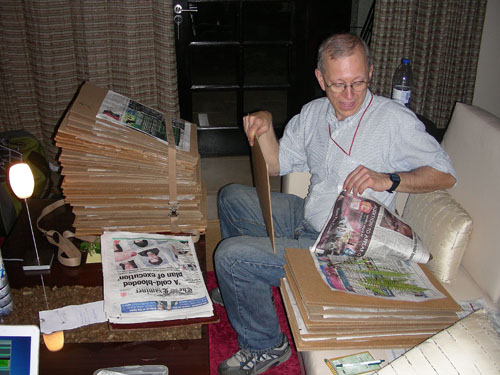
[Tom pressing]
Tom Daniel, veteran of GG III has also done well. We interact closely with Bom Sucesso, the herbarium and botanical garden. We have presented all of our publications to them over the years, but this year we also brought the formal identification labels for the duplicate material Tom and Rebecca collected in 2008. The curator of the herbarium, Faustino De Oliviera (below) was happy to receive them.

Faustino de Oliviera, Curator, Bom Sucesso. T. Daniel phot. GG IV
On the most recent foray up the mountain, Tom collected our first and only example of an endemic impatiens; it is a huge group but this one is truly beautiful.
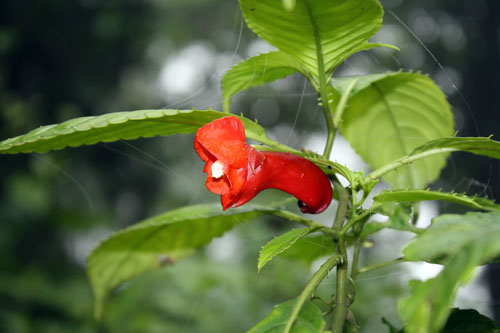
Impatiens thomensis T. Daniel phot. GG IV
One of the many endemic species of birds on the island is the Sao Tome Speirops, a relative of the African whiteyes. One apparently flew into a window while we were there. The little critter recovered, but this gave us an opportunity to get some pretty close shots. I have also had a chance to go up to the secret tree to see if Hyperolius thomensis breeds there. They do; we saw only one juvenile but plenty of egg masses on the walls of the tree holes.(see Glorious Ghost in the Forest).
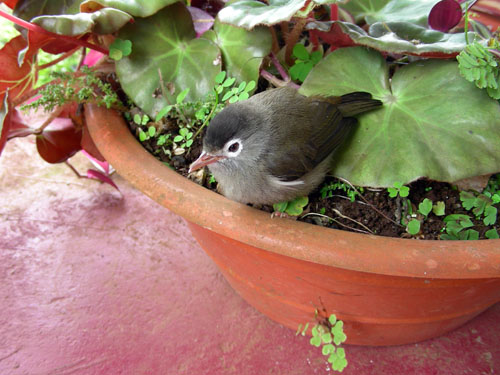
Endemic Speirops recovering on flowerpot, Bom Sucesso. RCD phot. GGIV
Last night we were invited to a true Sao Tome dinner at a tiny plantation called Nova Moca.. Our host was Ricardo Lima, my grad student colleague from the University of Lancaster (earlier blogs). The dinner was wonderful, but no power, so no pictures. But, Jose presented me with our first shrew specimen, we collected our first millipedes for the expert at the North Carolina State Museum, and I was able to show Roberta her first Cobra bobo. Also present was another grad student friend, Maryana Carvalho, who is studying hunting practices here. Maryana is very interested in our education projects.
While the botanists get to go up and down the mountain, Roberta and I have a series of meetings throughout this coming week. I will post as often as I can.
The parting shot:
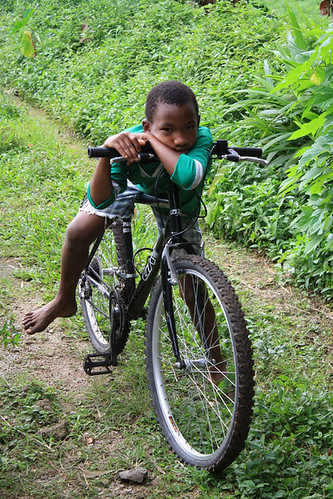 Interested on-looker. Nova Moca. Phot. T. Daniel. GG IV
Interested on-looker. Nova Moca. Phot. T. Daniel. GG IV
PARTNERS
We gratefully acknowledge the support of the G. Lindsay Field Research Fund, Hagey Research Venture Fund of the California Academy of Sciences, the Société de Conservation et Développement (SCD) and Africa’s Eden for logistics, ground transportation and lodging, STePUP of Sao Tome http://www.stepup.st/, Arlindo de Ceita Carvalho, Director General, and Victor Bomfim, Salvador Sousa Pontes and Danilo Barbero of the Ministry of Environment, Republic of São Tomé and Príncipe for permission to export specimens for study, the continued support of Bastien Loloumb of Monte Pico and Faustino Oliviera, Director of the botanical garden at Bom Sucesso. Special thanks for the generosity of private individuals, George G. Breed, Gerry F. Ohrstrom, Timothy M. Muller, Mrs. W. H. V. Brooke, Mr. and Mrs. Michael Murakami, Hon. Richard C. Livermore, Prof. & Mrs. Evan C. Evans III and Mr. and Mrs. Robert M. Taylor for helping make these expeditions possible. Our work can be supported by donations to CAS-Gulf of Guinea Fund.